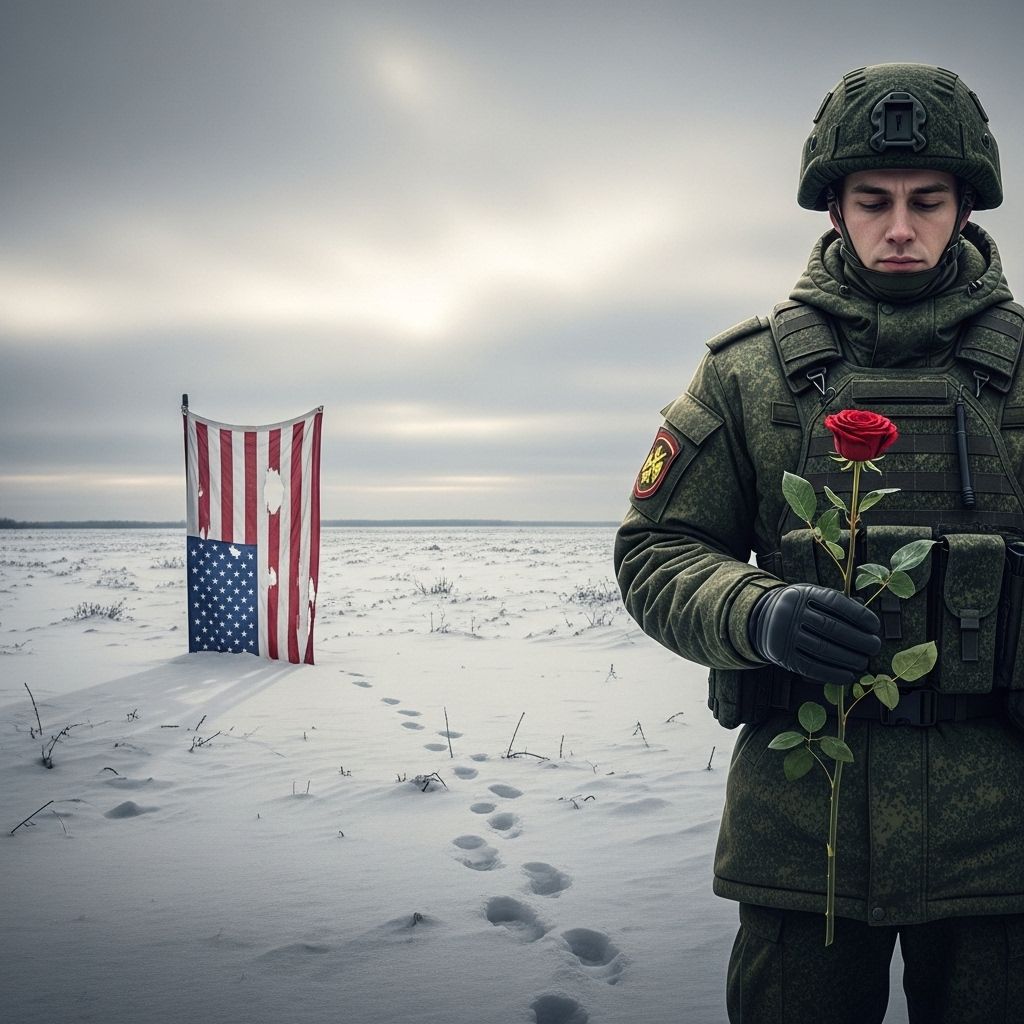How Russia Wishes the US a Happy July 4th Holiday
On Independence Day, Russia signals strategically with aerial gestures that mix tradition, rivalry, and power politics.

Every year, July 4th marks a momentous occasion for Americans—Independence Day, a celebration of freedom and the foundational ideals of the United States. While parades, fireworks, and gatherings light up the country, thousands of miles away, Russian military aircraft perform maneuvers that are, depending on perspective, either provocative power plays or messages of uneasy goodwill. From radio greetings to high-stakes intercepts, Russia’s approach to US airspace on this holiday has deep strategic, symbolic, and historical significance.
Russian Military Aircraft and Their July 4th Ritual
On several July 4ths in recent years, Russian Tupolev bombers—particularly the nuclear-capable TU-95 “Bear”—have flown near US borders, entering the North American Air Defense Identification Zone (ADIZ), prompting swift interception by American fighter jets. In most cases, these flybys are intercepted peacefully, but their timing and nature highlight Russia’s intent to assert its presence and, at times, deliver a direct message to American pilots.
- 2015 Incident: Two Russian TU-95 bombers entered the ADIZ near Alaska, where US F-22 Raptor fighters intercepted them. One Russian pilot radioed, “Good morning, American pilots, we are here to greet you on your Fourth of July Independence Day.” Only an hour later, two more Tupolev bombers appeared off the coast of California and were intercepted by F-15 Eagles, though without further greetings. During this incident, Russian President Vladimir Putin called President Barack Obama to wish him a happy Fourth of July.
- 2012 and Earlier: Russian military flybys near the West Coast have occurred on Independence Day in previous years, though not always accompanied by spoken greetings. American fighter jets have intercepted Russian aircraft an average of ten times annually since 2014, according to defense officials.
This tradition is not only about proximity but is laden with meaning—symbolic messaging, muscle-flexing, and, sometimes, the thinly veiled threat implicit in the presence of nuclear-capable bombers.
Understanding Airspace: ADIZ and Rules of Engagement
To grasp the importance of these incidents, it is essential to understand what constitutes US airspace and how military aircraft are monitored.
- US Airspace: Officially begins 12 miles from the US coastline.
- ADIZ (Air Defense Identification Zone): Established to enable early identification of incoming aircraft. Foreign military planes must file a flight plan specifying the time and duration of penetration at least 15 minutes prior to entering the zone.
- Interception Protocol: Failure to file a flight plan or suspicious maneuvers results in armed interception by US fighter jets. These encounters rarely escalate; typically, the fighters escort the aircraft out of range.
| Zone/Area | Description | Usual Protocol |
|---|---|---|
| US Airspace | 12 miles from coastline inward | State-controlled; unauthorized entries trigger defense responses |
| ADIZ | Extended buffer zone for early detection | Mandatory filing; intercepts if protocol broken |
| International Airspace | Beyond national jurisdiction | Freedom of movement; no intercepts unless threat detected |
Is This More Than Tradition? Geopolitical Symbolism
While there is a ceremonial aspect to these flybys—exemplified by greetings and direct presidential communication—they are also strategic gestures, meant to remind the US of Russia’s military capabilities and global reach. These acts serve as annual symbolic salutes, but they also double as subtle warnings, reflecting mutual suspicion and the enduring rivalry between the two superpowers.
- Military Capability: Russian TU-95s are nuclear capable. Their presence so close to American shores is inherently provocative, regardless of spoken civility.
- Strategic Messaging: July 4th is America’s day of patriotic pride, and these maneuvers are timed for psychological effect, suggesting Russian willingness to challenge US dominance—even if just symbolically.
- Presidential Signaling: Direct greetings, such as Putin’s phone call to Obama in 2015, provide dual messaging: outward goodwill, inner rivalry.
Routine Intercepts: Beyond July 4th
While these events are made notable by their timing and messaging, they are part of a broader trend. Russian military aircraft are intercepted routinely by the US and NATO forces near ADIZ and European airspace throughout the year.
- Defense officials report an average of 10 Russian intercepts annually off the US West Coast since 2014.
- In 2019, NATO reported nearly 300 intercepts of Russian aircraft near European airspace.
- In March and April 2020, US and Canadian planes intercepted two Tu-142 and two IL-38 maritime reconnaissance aircraft in the Alaskan ADIZ.
Generally, these encounters proceed peacefully—fighters identify, intercept, escort, and record the event for further analysis. Occasionally, they involve radio exchanges, visual signals, and polite to pointed messaging.
Comparing Experiences: NATO and US Intercepts
| Region | Interception Frequency | Common Aircraft Types | Typical Outcome |
|---|---|---|---|
| US West Coast | Approx. 10/year since 2014 | TU-95, TU-142, IL-38 | Escort out of ADIZ; peaceful disengagement |
| Europe (NATO) | Nearly 300/year (2019) | TU-95, SU-27, SU-35 | Escort or visual signals, sometimes tense standoffs |
| Alaska ADIZ | 2 incidents early 2020 | TU-142, IL-38 | Identification, brief escort, no escalation |
The Human Element: Pilots, Exchanges, and Protocols
Despite the overarching tension, the interactions between individual pilots are often marked by professionalism, if sometimes tinged with humor, curiosity, or understated bravado. The 2015 radio message, “Good morning, American pilots, we are here to greet you on your Fourth of July Independence Day,” illustrates a brief break from the norm—a moment where camaraderie and rivalry coexist in the stratosphere.
- Radio exchanges are rare, but when they occur, they usually reflect mutual respect.
- Pilots document the intercepts as part of their operational procedure, adding a unique story to their logs.
- US fighter pilots often debrief these encounters, reporting details of conduct and communication to superiors.
Why Does Russia Do This?
The underlying motivations for Russia’s July 4th encounters with US airspace are a blend of:
- Celebratory Gesture: Superficially, it’s an acknowledgment of a significant US holiday. The spoken greetings and phone calls reinforce this aspect.
- Psywar and Political Signaling: The timing is deliberate—a reminder of Russian capability, presence, and willingness to challenge US sanctity even on a day of national pride.
- Routine Operations: Maintaining readiness, testing responses, and gathering intelligence on US procedures and capabilities.
Public and Political Reactions in the US
Such incidents prompt a variety of responses in the United States, from public intrigue and media coverage to internal military analysis and political commentary. While most intercepts are downplayed as standard protocol, those on Independence Day garner attention for their symbolic nature.
- Media outlets report on the incidents with a mix of concern and fascination.
- Officials reassure the public that US airspace remained secure, with protocols functioning as intended.
- Policymakers sometimes use these incidents to highlight the ongoing military rivalry or to justify defense expenditure and strategic readiness.
How Frequent Are Such Greetings?
Though the 2015 incident is notable for its spoken message, verbal greetings from Russian pilots are not a regular occurrence. Russian flybys on July 4th are more common—sometimes annually, sometimes less frequently—while explicit radio communication is rare enough to stand out in official reports.
- The average of 10 interceptions per year since 2014 includes both July 4th and routine flights.
- Most occasions go without any verbal greetings, relying instead on radio silence and visual protocol.
- The most memorable events, like the 2015 message, become part of military lore.
Peaceful Yet Tense: The Nature of Military Intercepts
Despite the potential for escalation, most intercepts are handled with professionalism and usually end without incident. Fighters escort the violating aircraft out, record details, and return to base.
- Escalation is rare; the emphasis is on identification, deterrence, and documentation.
- Incidents are monitored at multiple levels—local command, NORAD, and Pentagon.
- Occasionally, incidents become diplomatic talking points or influence bilateral relations.
Conclusion: Ceremony and Signal
The July 4th flybys by Russian aircraft are more than just festive gestures or routine military antics. They are layered with meaning, representing centuries of rivalry and respect, tension and tradition. For the pilots involved, it’s a brief moment where global politics meets the personal—an exchange that’s recorded, remembered, and retold.
- On the surface, Russia’s July 4th incursions might seem trivial or ceremonial.
- Yet, they reaffirm the persistent realities of geopolitical competition and highlight the importance of readiness—and symbolism—in great power relations.
- Each event becomes another chapter in the long, complex history of US-Russia encounters—a blend of message, might, and meaning.
Frequently Asked Questions (FAQs)
Q: What is the ADIZ and why does it matter in these incidents?
A: The Air Defense Identification Zone (ADIZ) is a perimeter surrounding US airspace, designed to give early warning of approaching aircraft. Russian military flights into the ADIZ trigger interception unless they have filed a flight plan.
Q: Do Russian aircraft ever enter official US airspace?
A: As of recent incidents, Russian military planes have not breached the official 12-mile US airspace limit but instead approach closely within the ADIZ, prompting US fighter response.
Q: Are these aerial encounters typically dangerous?
A: Most intercepts are professional and end peacefully, with US planes escorting Russian aircraft back out of the ADIZ. Both sides maintain strict protocols to avoid escalation.
Q: Has this ever happened on other holidays?
A: While July 4th is notable, Russian military flybys can occur at various times of year, though verbal greetings and symbolism are most prominent on US Independence Day.
Q: How does US military respond to these incidents internally?
A: US military commanders analyze each encounter, reviewing pilot reports, air defense performance, and communication, using them to refine protocols and strategy.
Further Reading
- “Russian Airstrikes on U.S. Independence Day” discusses how Russia used aerial attacks on July 4th as a form of symbolic messaging.
- “Putin Congratulates Trump on Independence Day” covers direct diplomatic exchanges coinciding with military gestures.
- NATO Aircraft Intercept Reports for broader context on global airspace rivalry.
References
- https://finchannel.com/on-u-s-independence-day-russia-launched-one-of-its-largest-air-attacks-of-the-full-scale-war/126815/featured/2025/07/
- https://www.military.com/off-duty/how-russia-wishes-us-happy-july-4th-holiday.html
- https://www.youtube.com/watch?v=53705SlfXeQ
- https://www.themoscowtimes.com/2025/07/03/putin-congratulates-trump-on-us-independence-day-during-hourlong-call-a89670
- https://www.russiamatters.org/news/russia-review/russia-review-july-25-aug-1-2025
- https://www.state.gov/releases/office-of-the-spokesperson/2025/07/secretary-rubio-delivers-a-message-for-july-4-2025
- https://economictimes.com/news/international/global-trends/us-independence-day-4th-of-july-celebrations-may-be-disrupted-from-next-year-courtesy-trump-china/articleshow/122202718.cms
- https://www.youtube.com/watch?v=Vma0_FUKB7o
Read full bio of Sneha Tete












